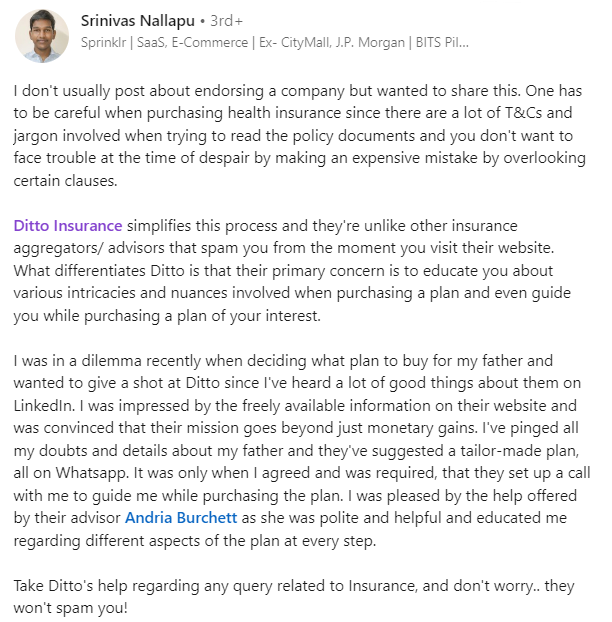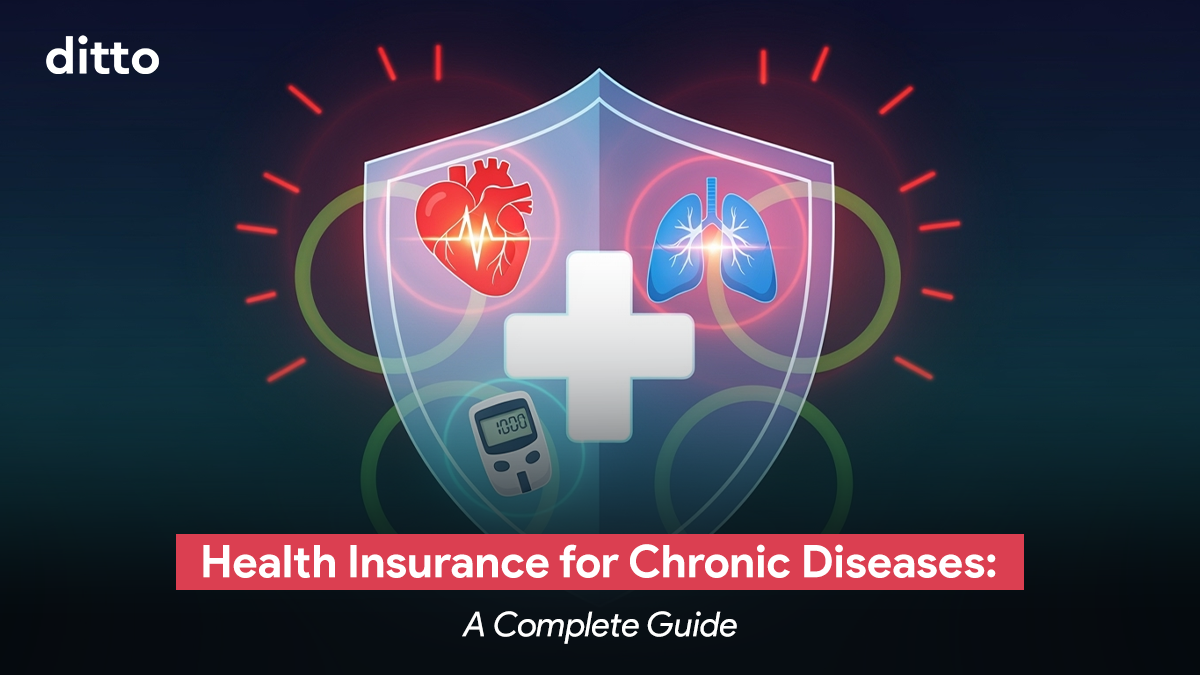| What is health insurance for chronic diseases? Health insurance for chronic diseases helps cover long-term conditions like diabetes, hypertension, asthma, and heart disease by including expenses such as hospitalization, medications, diagnostics, and preventive care. If diagnosed after purchase, treatment is typically covered as per policy terms. However, if it is a pre-existing condition (PED), coverage will depend on factors like the severity of the illness, the insurer’s underwriting, and may involve higher premiums, waiting periods, permanent exclusions, or in rare cases, rejection of the application. Premiums are generally higher, and some plans may also include co-payments or sub-limits. |
Living with a chronic illness such as diabetes, hypertension, or heart disease often means dealing with lifelong medical care, recurring expenses, and the stress of unexpected hospitalizations. These conditions don’t just impact health, they also create a steady financial burden through doctor visits, medicines, tests, and long-term treatments.
This is where health insurance for chronic diseases becomes essential. In this blog, we’ll explain what health insurance for chronic diseases is, which conditions are usually included or excluded, tips for selecting the right plan, and our top recommendations for 2025.
Not sure which riders you actually need? Talk to Ditto’s expert advisors today and get unbiased, personalised guidance - absolutely free.
What is Chronic Disease in Health Insurance?
In health insurance terms (as per IRDAI), a chronic disease is a long-lasting health condition that requires ongoing medical care, regular monitoring, and potentially lifestyle adjustments to manage its symptoms and progression. These conditions may persist indefinitely and can fluctuate or recur over time.
Types of Chronic Diseases Covered Under Health Insurance
The Insurance Regulatory and Development Authority of India (IRDAI) does not provide a definitive exhaustive list specifically titled as "Chronic Diseases Covered Under Health Insurance." Instead, they regulate broader categories of diseases and specify mandatory coverage and exclusions.
Health insurers in India usually cover a wide range of chronic diseases either under the base policy or via add-on covers after a stipulated waiting period.
Below are the common chronic diseases typically covered under health insurance in India include:
- Diabetes (Type 1 and Type 2)
- Hypertension (high blood pressure)
- Asthma and chronic respiratory diseases
- Cardiovascular diseases such as coronary artery disease, heart failure
- High cholesterol (hyperlipidemia)
- Chronic kidney disease
- Arthritis (rheumatoid arthritis, osteoarthritis)
- Stroke and related neurological disorders
- Chronic liver diseases (such as cirrhosis, fatty liver, hepatitis)
- Cancer (when considered chronic/long-term under specific plans)
Disclaimer: The types of chronic diseases covered and the extent of coverage vary by insurance provider, policy terms, and jurisdictions. It is important to carefully read the health insurance for chronic diseases policy document or consult with an advisor to understand coverage specifics, limitations, exclusions, and claim procedures.
Chronic Conditions Not Covered by Health Insurance
When it comes to health insurance for chronic diseases, exclusions and limitations usually depend on whether the condition was diagnosed before or after buying the policy.
1. If Diagnosed Before Purchase (Pre-Existing Disease – PED):
- Most insurers impose a waiting period of 2–3 years before covering treatment for Pre-existing Diseases (PEDs) like diabetes, hypertension, or heart disease.
- Depending on the severity, insurers may apply:
- Loading (higher premium)
- Co-payments or sub-limits
- Permanent exclusions (for very high-risk cases such as advanced cancer or severe kidney disease)
- In rare cases where the risk is too high, application rejection.
2. If Diagnosed After Purchase:
- If a condition is diagnosed after the purchase of a health insurance policy, it is treated as a new illness and is generally covered only after a specified waiting period. This waiting period begins from the policy start date and must be completed before the insurer will cover expenses related to that illness. In such a scenario, it’s important to inform your insurer proactively and obtain written acknowledgement from the insurer to avoid complications during future claims.
- Exclusions may still apply in cases such as:
- Experimental or advanced-stage treatments (e.g., gene therapy, unapproved drugs)
- Lifestyle-related illnesses not disclosed earlier (e.g., liver cirrhosis due to alcohol abuse, COPD due to smoking)
- Treatment from excluded providers (blacklisted or non-recognized medical facilities)
- Cosmetic or plastic surgery, unless medically necessary (e.g., post-accident or post-cancer reconstruction)
Tips for Selecting Health Insurance for Chronic Conditions
1. Waiting Period for Pre-Existing Diseases (PEDs)
Most health insurance for chronic diseases impose a waiting period of 1–3 years for pre-existing chronic conditions like diabetes, hypertension, or heart disease. During this period, claims related to these conditions are generally not covered.
- Some plans offer reduced waiting periods with optional add-ons or riders.
- Examples:
- HDFC ERGO Energy covers certain chronic conditions (diabetes or hypertension) from Day 1, making it suitable for patients already managing diabetes or hypertension.
- Care Supreme offers multiple riders to shorten waiting periods and cover more diseases.
- Always check how soon the policy starts covering treatment expenses for your specific condition.
Also, read our detailed guide on health insurance plans covering pre-existing diseases from Day 1 to explore faster coverage options.
2. Coverage for Regular Treatment and Hospitalization
- When choosing health insurance for chronic diseases, ensure it covers the basics—no room rent limits, no co-pays, no disease-wise caps, and consumables included.
- For better chronic care management, look for plans/riders that offer Day-1 coverage and ongoing support. For example, Aditya Birla Activ One Max (Day-1 cover + disease management), HDFC ERGO Energy (Day-1 cover for diabetes/hypertension with wellness programs).
3. Restoration Benefits
- In health insurance for chronic diseases, look for comprehensive restoration and bonus features.
- Restoration should apply unlimited times, for both same and different ailments, on partial or full exhaustion of cover, without any cooling-off period.
- Additionally, opt for plans offering a bonus of at least 100% of the base sum insured, even if claims are made, to ensure sustained protection against recurring treatments.
4. Outpatient and Preventive Care
Many insurers offering health insurance for chronic diseases now include OPD coverage and preventive care.
- Aditya Birla Activ One Max Plan covers a chronic management program that includes OPD consultations.
- HDFC ERGO Optima Secure offers comprehensive OPD and wellness support tailored for chronic care via its Optima Well being add-on.
- Niva Bupa Aspire delivers an impressive package of tele-consults, diagnostics, fitness perks, and renewal benefits.
5. Premiums & Loading Charges
- With health insurance for chronic diseases, individuals may face higher premiums (loading charges), which are additional percentages added to the base premium to account for the higher likelihood of claims.
- Most insurers apply 10–50% extra depending on the severity and type of chronic condition.
- In cases with multiple co-morbidities, some insurers may charge up to 100% extra.
6. Variation in Covered Chronic Conditions
- Each insurer defines chronic conditions differently. Some cover multiple conditions by default, while others may require add-ons or riders.
- Examples:
- Aditya Birla Activ One Max, through its Chronic Care rider, provides Day 1 in-patient hospitalization coverage for seven listed chronic conditions: diabetes, hypertension, asthma, hyperlipidemia, chronic obstructive pulmonary disease (COPD), obesity, and coronary artery disease (Percutaneous Transluminal Coronary Angioplasty (PTCA) done prior to 1 year)
- HDFC ERGO Energy covers five conditions: Type 2 Diabetes Mellitus, Impaired Fasting Glucose (IFG), Impaired Glucose Tolerance (IGT), Type 1 diabetes and/or Hypertension.
7. Cashless vs. Reimbursement
- Most plans under health insurance for chronic diseases provide cashless treatment at network hospitals, ensuring hassle-free care.
- Reimbursement is available if treated at a non-network hospital.
8. Practical Tips
- When purchasing health insurance for chronic diseases, always disclose all pre-existing conditions to avoid claim rejection.
- Maintain proper records of check-ups, prescriptions and doctor consults.
- Choose plans with minimal waiting periods or optional riders to reduce them for quicker coverage.
- Check co-payments, sub-limits, and exclusions to ensure financial protection.
- Buying health insurance early, before any diagnosis, ensures future diseases are covered, helps complete waiting periods in advance, and avoids higher premiums due to loading charges.
Key Takeaway:
Choosing the right health insurance for chronic diseases requires balancing coverage, waiting periods, premiums, and riders. Focus on plans with quick PED coverage, cashless facilities, and restoration/wellness benefits to manage chronic conditions effectively and affordably.
Health Insurance Plans for Chronic Diseases (2025) That Make Ditto’s Cut
| Before we jump into the list, here’s how we decide what “best” means. At Ditto, every plan goes through our six-point evaluation framework. This framework is why we’re comfortable using the word “best.” It doesn’t mean these are the only good plans, but that they stand out after being scored across all six pillars. You can learn more about how we evaluate the plans here. |
The following health insurance plans offer specialized coverage for chronic conditions and leverage riders or add-ons to reduce standard waiting periods for pre-existing diseases (PEDs).
| Plan Name | Standard Waiting Period (PED) | How Waiting Period is Reduced |
|---|---|---|
| HDFC Ergo Optima Secure | 3 years | Reduced to 30 days with ABCD Chronic Care Rider for Asthma, Hypertension, Cholesterol, Diabetes |
| Care Supreme | 3 years | Offers 3 Riders: -PED Waiting Period (WP) Reduction (reduces WP to 1 or 2 years) -Instant Cover Plus (reduces to 30 days for: Hypertension, Diabetes, Cholesterol, Asthma, Obesity, Chronic Obstructive Pulmonary Disease (COPD), Obesity or Coronary Artery Disease (PTCA done prior to 1 yr) |
| Aditya Birla Activ One Max | 3 years | -Chronic Care Rider provides Day 1 coverage for declared chronic conditions (same as in Care Supreme’s Instant Cover Plus); -PED Reduction Rider cuts waiting period to 1 or 2 years. |
| Niva Bupa Reassure 2.0 | 3 years | Disease Management Rider: Day 1 cover for diabetes & hypertension |
| ICICI Lombard Elevate | 3 years | -Jump Start reduces waiting period to 30 days (Asthma, Diabetes, Hypertension, Hyperlipidaemia, Obesity (BMI > 35) or PTCA done earlier) -Reduction in PED reduces waiting period to 1 or 2 years |
| Star Super Star | Standard waiting | Quick Shield Rider: Day-31 coverage for Hypertension, Diabetes, Heart Disease, Asthma, and Hyperlipidemia -Reduction in PED reduces waiting period to 1 or 2 years |
Summary of Best Picks
- Fastest coverage: Aditya Birla Activ One Max and Niva Bupa Reassure 2.0 (Day 1).
- Comprehensive chronic coverage: Care Supreme, ICICI Lombard and Star Super Star.
- Simplest waiting period reduction: HDFC Optima Secure and Niva Bupa Reassure 2.0.
Note: The above list is not exhaustive and is based on our research. While these plans are likely to cover the mentioned conditions, approval is not guaranteed and depends on factors such as medical reports, condition severity, and individual assessments.
What if Applications Are Rejected Due to High-Risk PEDs?
When health insurance applications are declined due to the severity or high risk of pre-existing diseases (PEDs), individuals have alternative options such as specialized plans designed specifically for chronic and high-risk conditions.
These typically have:
- Shorter waiting periods (often around 1 to 2 years instead of the usual 2–3).
- Cost-sharing features like copayments and sub-limits, which increase out-of-pocket expenses but help insurers manage higher claims risk and keep premiums more affordable.
- Focused coverage for common chronic ailments such as diabetes, hypertension, obesity, and kidney diseases.
- Added support through wellness programs and disease management initiatives.
Notable Specialized Plan:
Care Freedom (Care Health Insurance):
- Tailored for lifestyle-related conditions like diabetes, high blood pressure, and obesity.
- 2-year waiting period for PEDs.
- Benefits include annual health check-ups, inpatient/daycare treatments, ambulance cover, domiciliary hospitalization, and sum insured recharge.
- Mandatory copayments (20–30%) and certain sub-limits are applied to reflect higher risk acceptance, particularly for procedures such as cataract surgery, knee replacement, and hernia repair.
- Ideal alternative for those denied coverage by standard/comprehensive plans by insurers.
Also, go through our detailed guide on the best health insurance plans in India for a breakdown of the top insurers and benefits.
Why Talk to Ditto for Your Health Insurance?
At Ditto, we’ve assisted over 8,00,000 customers with choosing the right insurance policy. Why customers like Srinivas below love us:

✅No-Spam & No Salesmen
✅Rated 4.9/5 on Google Reviews by 15,000+ happy customers
✅Backed by Zerodha
✅Dedicated Claim Support Team
✅100% Free Consultation
You can book a FREE consultation. Slots are running out, so make sure you book a call now!
Final Key Takeaways
- Health insurance for chronic diseases helps manage long-term costs of conditions like diabetes, hypertension, heart disease, and asthma.
- Coverage depends on PED status: pre-existing conditions may have waiting periods, higher premiums, or co-payments; new diagnoses are usually covered immediately.
- Riders like Instant Cover (Care Supreme), Chronic Care (Aditya Birla Activ One Max), and Start (ICICI Elevate) can shorten waiting periods and support disease management.
- Cashless treatment is available at network hospitals, with added value from restoration benefits, wellness programs, and OPD coverage.
- Premiums may include loading charges and rise over time for the overall customer pool.
- Early purchase and honest disclosure ensure future coverage and help avoid claim issues; lifetime renewability provides continuous protection.
Still confused? Speaking to Ditto’s IRDAI-certified advisor can help you pick the right plan for your health and budget. So, book a free consultation with our advisor today.
FAQs
Do All Health Insurance Plans Cover Chronic Diseases?
Not all health insurance plans offer the same level of protection for chronic diseases. Coverage depends on whether the condition existed before or after purchasing the policy:
- If diagnosed after buying the policy: Coverage is usually available immediately, since the illness was not pre-existing at the time of purchase. It’s important to inform your insurer proactively and obtain written acknowledgement to avoid complications during future claims.
- If it is a Pre-Existing Disease (PED): Always declare it honestly at the time of application. You may need to provide medical records, undergo tests, or attend a doctor’s evaluation. Depending on the insurer’s assessment, coverage may be offered with:
- Premium loading (higher premiums), and/or
- A waiting period of 1–3 years for the PED.
Some insurers also offer riders that can reduce or even waive the waiting period for specific chronic conditions, providing faster access to treatment.
How Do Insurers Mostly Cover Chronic Diseases?
Insurers usually structure health insurance for chronic diseases through built-in coverage, waiting periods, or optional riders. Most policies cover hospitalization, surgeries, and treatment costs only after the waiting period ends. Pre-existing conditions are subject to stricter clauses, and sub-limits may apply. Riders are often added to enhance health insurance for chronic diseases, offering quicker access to claims and broader coverage.
How do premiums change for chronic disease claims?
Premium changes for chronic disease coverage:
- Higher Premiums: Insurers charge higher premiums for policies that cover chronic pre-existing diseases because these conditions pose a greater ongoing risk.
- Premium Loading: This is an additional amount added to the base premium at policy purchase if the insured has an existing chronic disease or pre-existing condition.
- Renewal Premium Increases: Health insurance premiums generally rise over time for the entire customer pool, not just an individual policy, due to aging risks, claims received and medical inflation.
- Shorter or Waived Waiting Periods: Opting for shorter waiting periods for chronic conditions often comes with paying higher premiums.
- Medical Check-ups: Results can influence premium rates and policy issuance.
How insurers restrict coverage for chronic disease treatments?
Here is how coverage limits work for chronic diseases:
- Waiting Periods: Coverage for chronic illnesses usually starts only after a waiting period of 1 to 3 years, depending on the insurer and condition.
- Sub-Limits: Some policies impose sub-limits or caps specifically for chronic disease treatments, limiting the amount payable under the policy for such claims.
- Co-Payments To manage costs, some insurers apply co-payments clauses to chronic disease claims, meaning you pay a part of the treatment cost.
Last updated on:










